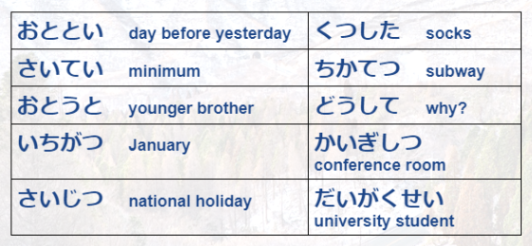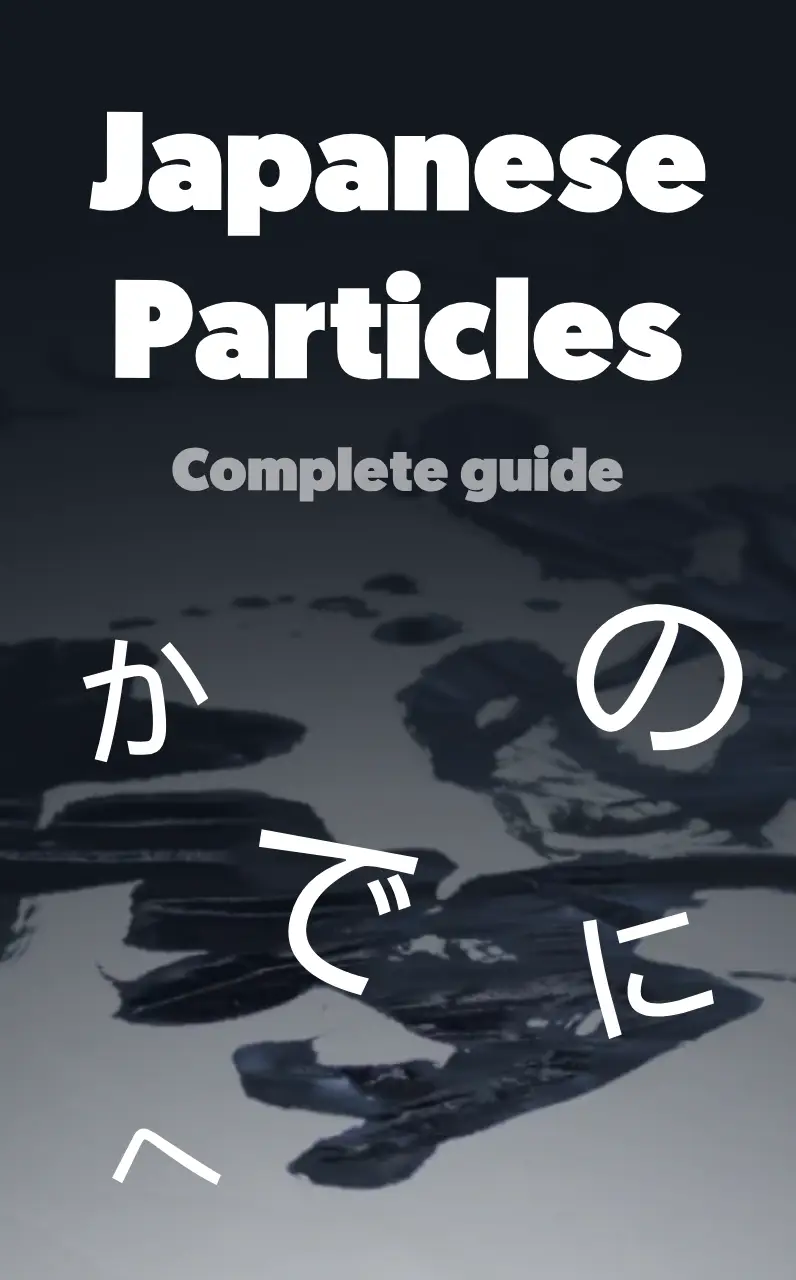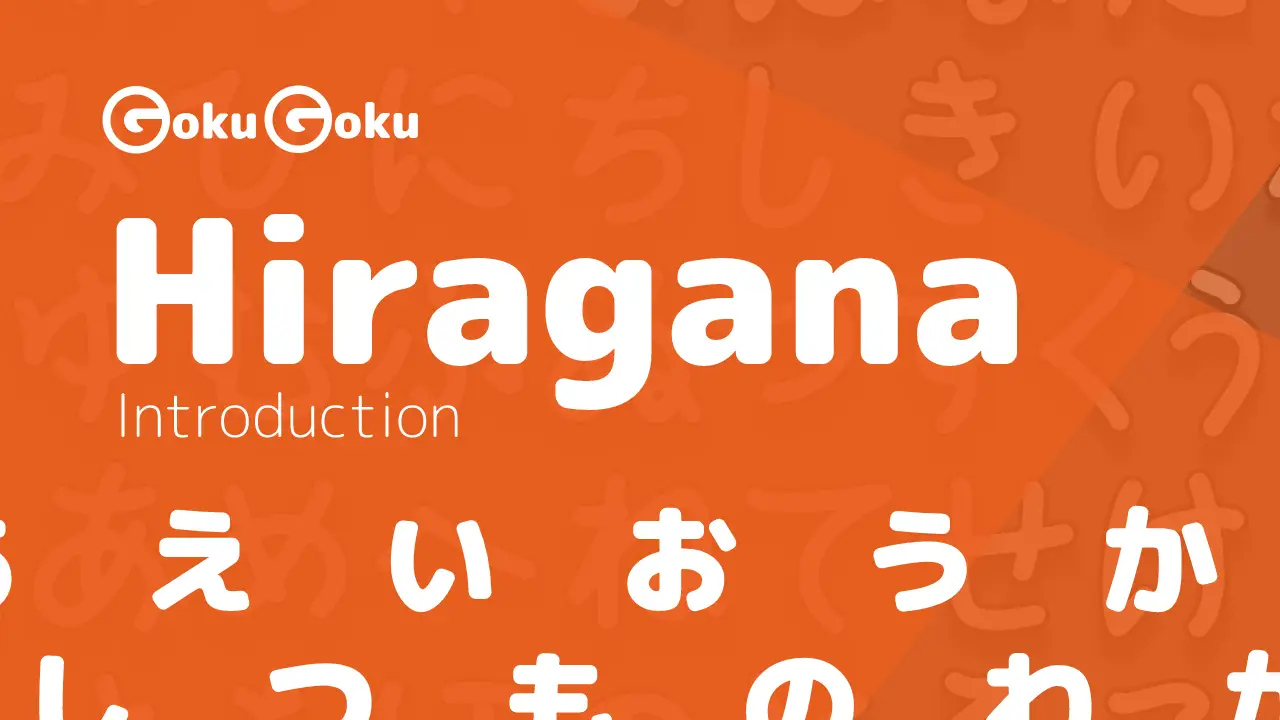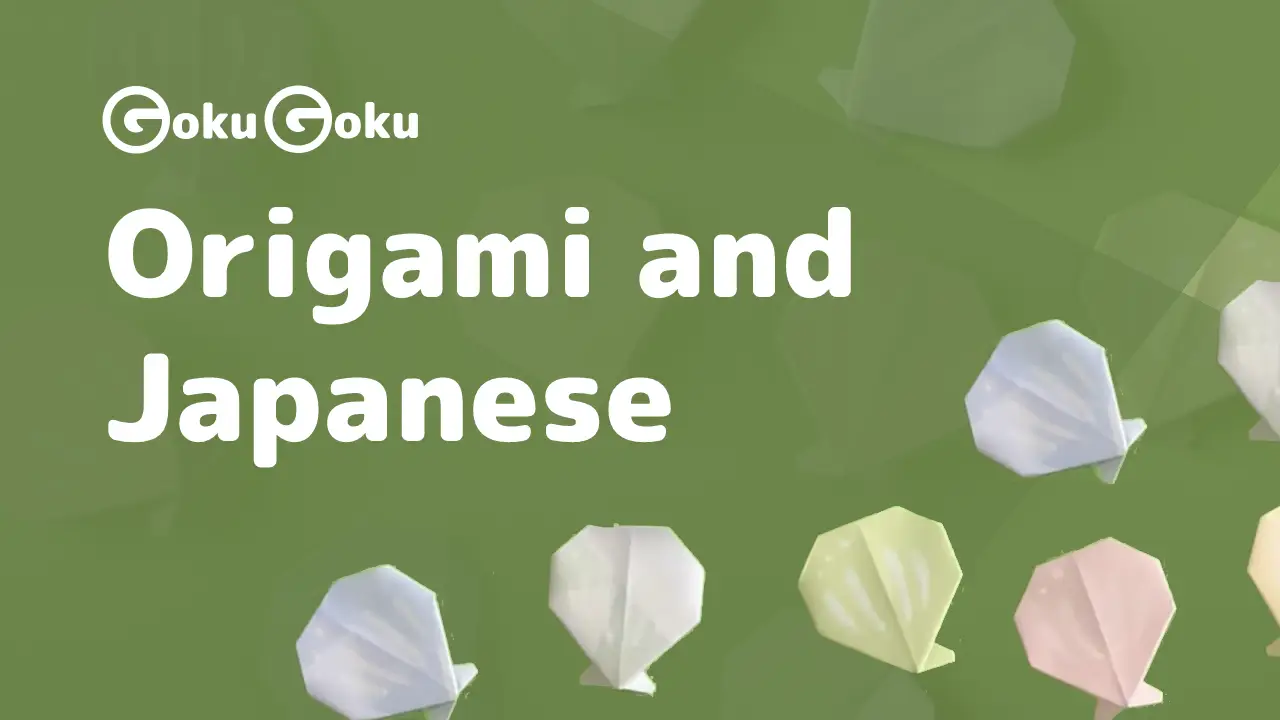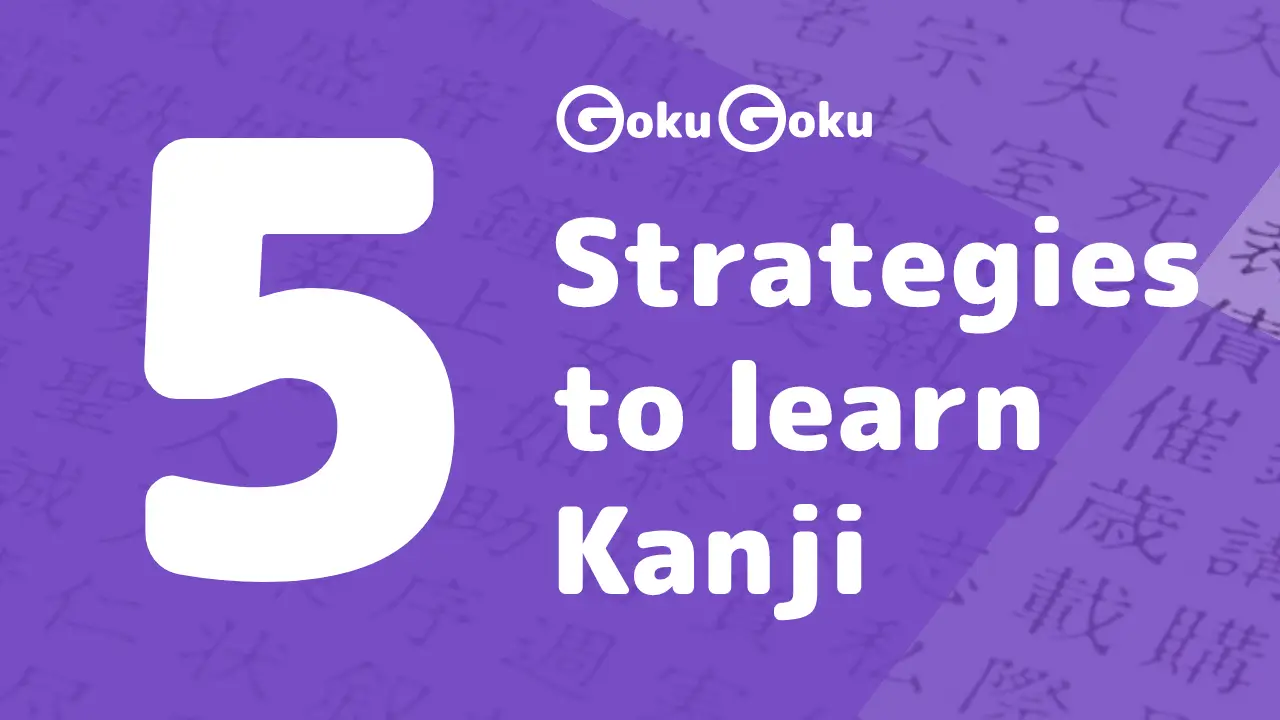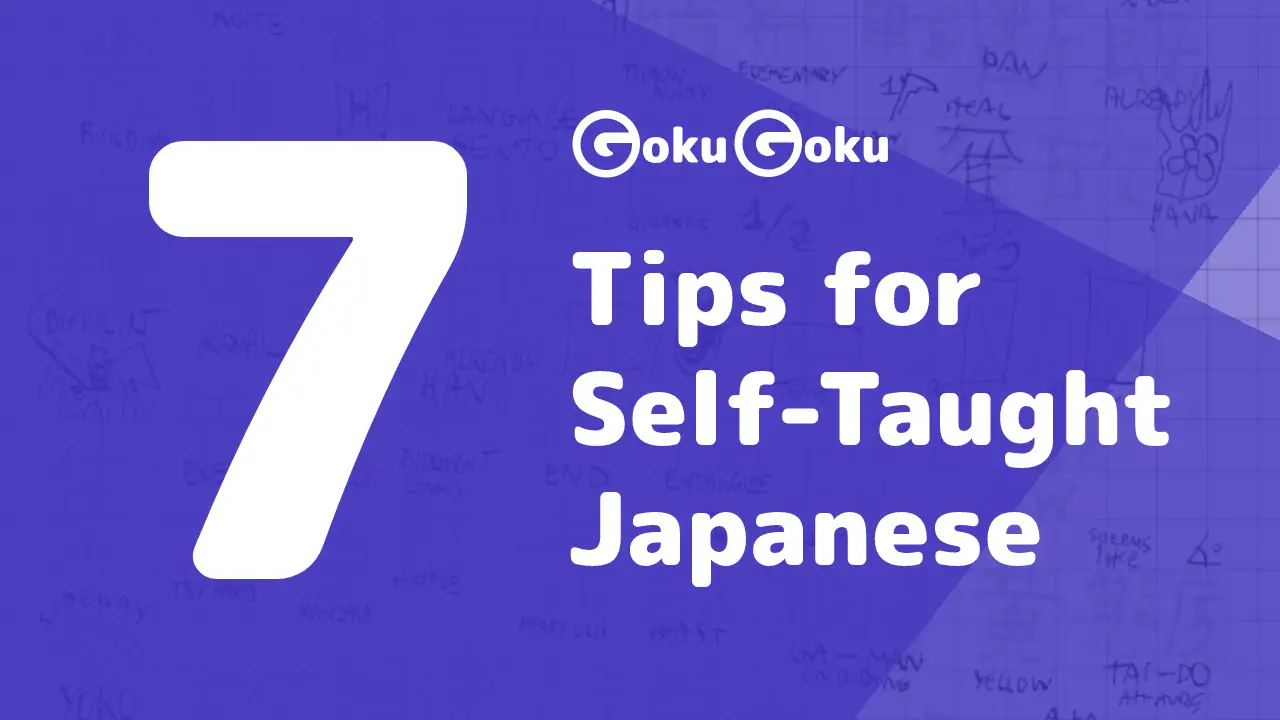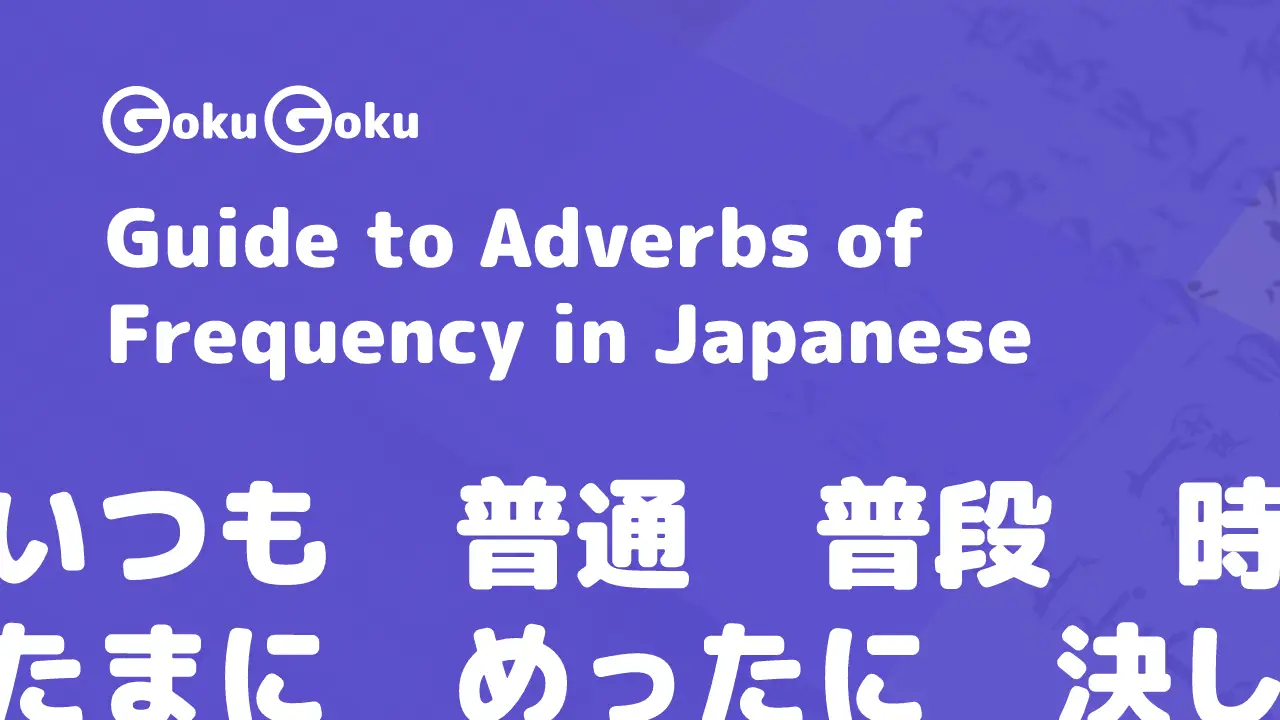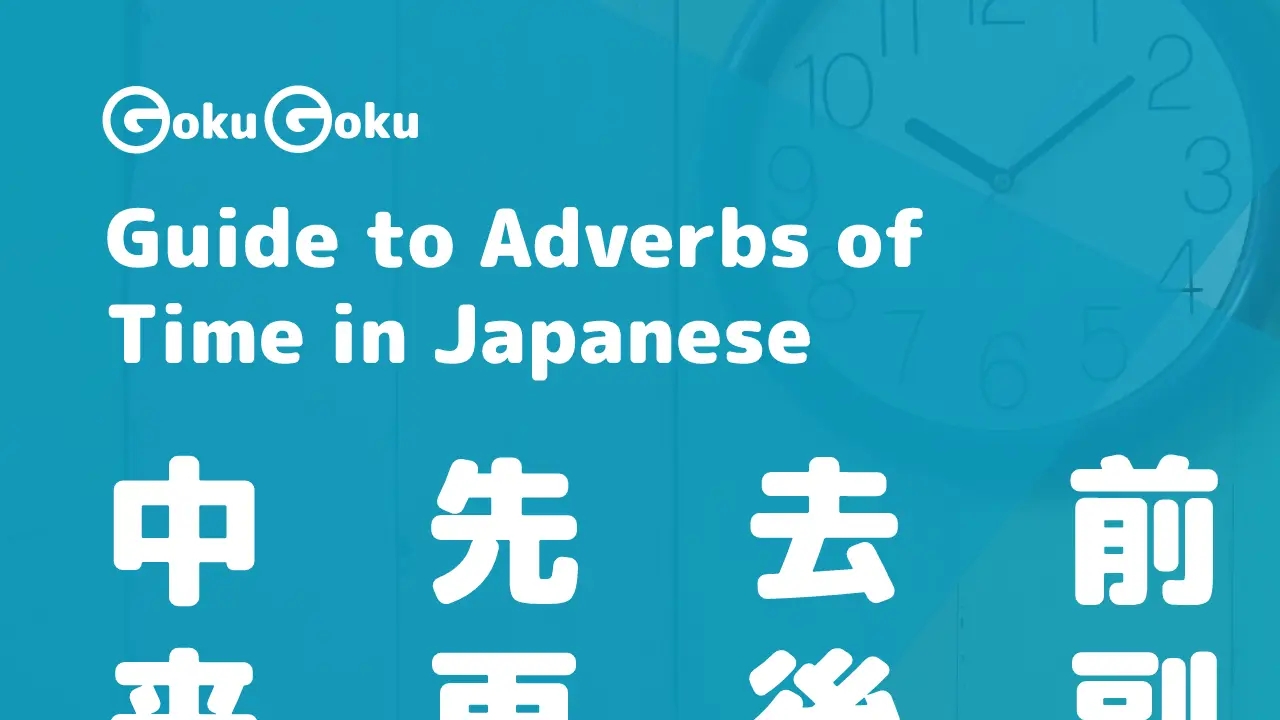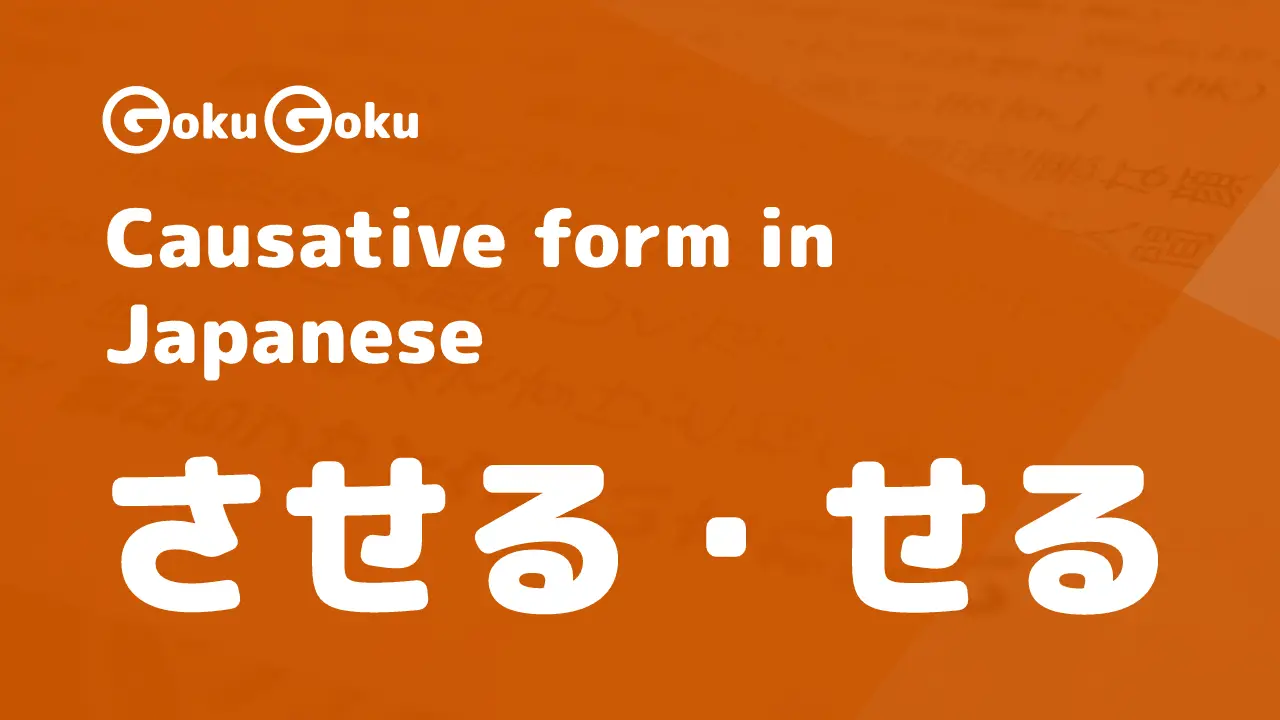Studying the Hiragana syllabary is the first step in learning the Japanese language.
Hiragana is one of 3 writing systems used in the Japanese language.
The Japanese word for Hiragana is 平仮名 and literally means common kana in the nuance of easy compared to Kanji, the ideographic system.
It developed during the early to middle Heian period (from 794 to 1185), when it was mainly used by women to write poems and letters; it is related to the word 女手 female help, female labor.
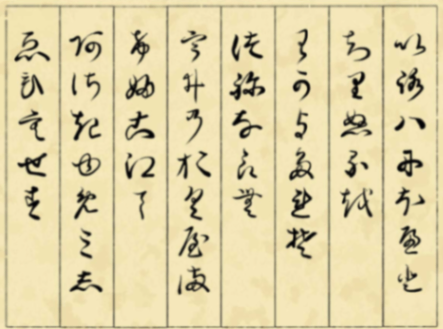
Transcription systems in Japanese
Three writing systems are used in Japanese that are integrated within the sentence and are:
- Hiragana Syllabary used to write Japanese words or grammatical inflections
- Katakana syllabary used for foreign words and technical terms of various professioanal fields, onomatopoeias, etc.
- Kanji: ideographic system
It is useful introduce the Rōmaji the Latin characters, used from foreigners to transcribe the Japanese phonetic.
Introduction to the Rōmaji reading system
In our first step it is useful to use the transcription with Latin characters, the alphabet in order to be able to read the characters. It was invented for non-Japanese people who couldn't read japanese characters.
Rōmaji, ローマ字, literally means Roman letters and refers to the Latin script that is used to pronounce the Japanese language for all the beginners. This method of writing is also called the romanization of Japanese.
This system is particularly known as "Hepburn" and takes its name from James Curtis Hepburn, the American missionary who created the reading system and published the first dictionary using western alphabet letters.
The characteristic feature of Hepburn system is the reading of consonants according to English phonology and the reading of vowels according to Italian, Spanish phonology.
When is Hiragana used?
Hiragana transcribes all Japanese phonetics; all sentences in Japanese can be written in Hiragana.
The Japanese writing system is ideographic, using Kanji, so the Hiragana syllabary is used to transcribe grammatical parts that Kanji does not include or even terms for which Kanji does not exist or is not used.
Characteristics of Hiragana
The syllabary consists of:
- the 5 vowels a, i, u, e, o
- the semiconsonant 'n'
- and characters representing syllables, elements composed of consonant + vowel
Hiragana and its sounds
Subdividing the nature of the sounds we find in the syllabary:
- 46 pure sounds
- 20 impure sounds
- 5 half-impure sounds
- 36 contracted sounds For the pronunciation of the various kana, the syllables, we follow English phonology for consonants and Italian phonology for vowels.
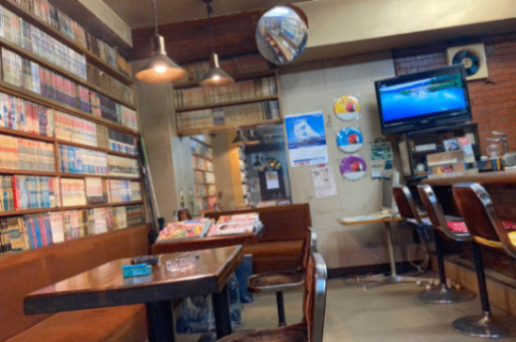
Seion, pure sounds
The pure soundsconsists of a group of 46 characters divided into 5 vowels, 40 syllables and 1 consonant represented by the letter ん "n ".
The pure sounds are called "seion " 清音 in Japanese, the first Kanji 清 means pure, purify, cleanse and 音 is the sound, the musical note; the term is translated as voiceless sounds.
Vowels, KA and SA lines

- The KA line is pronounced like the K in the English word Key.
- Shi is read as in the word Cash.
- The sound of the S is as in Student.
Read the following terms and find the transcription in Rōmaji; you'll find the varioustranscription of the terms at the end of the post.
- すし Japanese typical dish:
- おかし
sweet,dessert: - かく verb
write: - きく verb
listen: - せかい
world: - えいこ female name:
- あきこ female name:
- けさ
this morning: - うし
cow: - そこ adverb
there:
The two characters あ and お might be confused, but if we look carefully they are different.
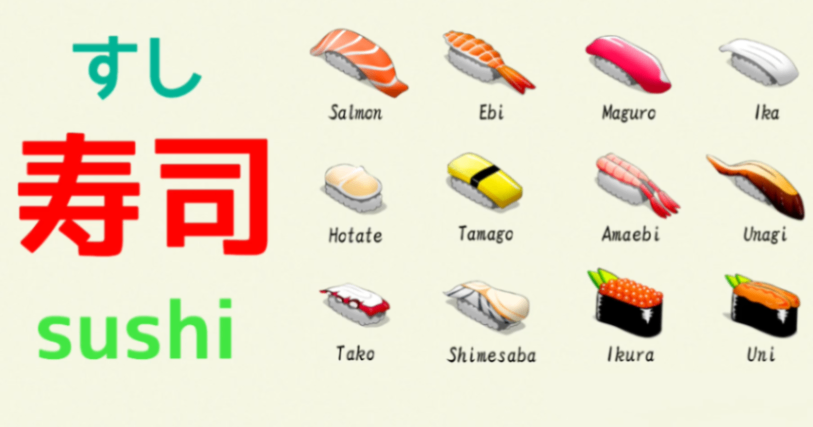
TA, NA and HA lines
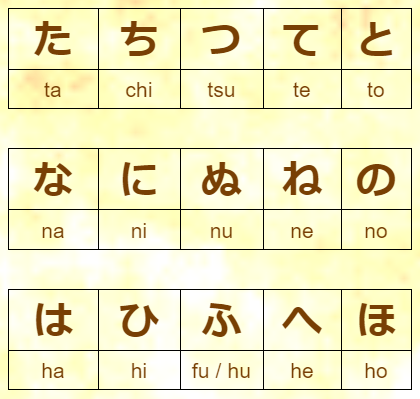
- CHI is read as in Church
- In order to reproduce the TSU pronunciation consider the word Suits in English
- The H is always aspirated, so the sound should be heard clearly.
- The syllable HU ふ sounds slightly like FU
Transcribe in Rōmaji:
- たつ verb
stand up: - ぬの
fabric: - いち number
1: - ふつか
second dayof the month: - おに
demon:
Transcribe in Hiragana:
- INU
dog: - OKANE
money: - HACHI number
8: - FUKUI Japanese prefecture:
- HIKU: verb
pull:
Long vowels
The Japanese term that translates "long vowels" is chōboin 長母音; 長 has the meaning of long and 母音 means vowel.

The vowel is thus doubled and the sound is lengthened.
All sounds in the Hiragana syllabary are lengthened according to the vowel with which that character ends.
Example:
* all syllables ending in あ will add the vowel あ: か/さ/た/な/は/ま/や/ら
- か + あ : ka + a = kaa ⇨ kā
- ま + あ : ma + a = maa ⇨ mā
In Rōmaji transcription, we generally find the use of the macron sign, the hyphen above the vowel that is to be lengthened.

Vowel あ lengthening
The vowel あ is added to the previous character.
- おかあさん okāsan
mother - おばあさん obāsan
grandmother
What happens if I do not pronounce the double vowels and the sound is not lengthened?
The meaning often changes, for example:
- おばさん without the long vowel becomes obasan and means
auntinstead of grandmother.
Vowel い lengthening
The vowel い is added to the previous character.
- にいがた
NiigataJapanese prefecture - おにいさん oniisan
elder brother - おじいさん ojiisan
grandfather
おじさん without the lengthening translates the word uncle.
Vowel う lengthening
We add the vowel う to the previous character.
- くうき kūki
air - つうしん tsūshin
communication,correspondence - ぬう nū verb
sew
If we omit the lengthening of the う into くうき, we get くき indicating the stem of a flower.
Vowel え lengthening
In a few words, the elongation of え is obtained by adding the vowel え; in most cases, the vowel い is added, which is still pronounced as え.
- おねえさん onēsan
elder sister - せんせい
masteris read せんせえ sensē, but is transcribed with the い - せんべい
rice cracker, read せんべえ senbē and transcribed with the final vowel い
The English language is translated えいご and pronounced eego, ēgo.
Vowel お lengthening
The lengthening of the vowel お is obtained by adding the vowel う which is read "o".
- うんどう undō
sport - きのう kinō
yesterday - おとうさん otōsan
father
For some terms, the elongation is obtained by adding the お instead of the う.
- こおり kōri, the
ice - とお tō, the number
10 - とおる tōru, verb
pass - とおい tōi, adjective
far
Transcribe the terms in Hiragana in a notebook and then compare them with the transcription at the end of the post:
- chiisai adjective
small: - kōkō
high school: - kūkan
space: - hōritsu
law: - sūji
numbers: - sonkē
respect:
Long vowels in Katakana
For Katakana syllabary, the rule is very simple: you add a line (ー) after the character whose vowel you want to lengthen.
- カード: kādo from card,
card. - メーカー: mēkā from maker,
manufacturer - ローマ: Rōma,
Roma - ニューヨーク: Nyū Yōku,
New York
Double consonants
The rule for doubling consonants is simple: the kana つ, transcribed in small, is placed before the consonant to be doubled.
In Japanese, the doubling of consonants is called ダーブる子音 dāburu shiin, double consonant.
Example: yottsu: yo / t / tsu ⇨ よ / っ / つ
- よっつ yottsu number
4 - きって kitte
stamp - しっけ shikke
moisture
Read and transcribe in Rōmaji the terms:
- いっかい
once: - ひこうき
airplane: - かっこう
appearance: - まっか
deep red color: - そっち adverb
that way: - きれいな adjective for
beautiful:
Double Consonants in Katakana
Katakana follows the same rule as Hiragana for doubling consonants.
The kana ツ written in small is placed before the consonant to be doubled.
- kappu: ka / p / pu ⇨ カ / ッ / プ from English
cup - セット setto,
set - キッチン kicchin,
kitchen - ペットボトル petto botoru,
PET bottle
Examples of common terms containing the long vowels
- おねえさん - onēsan, the
elder sister - こうこう - kōkō, the
high school - おかあさん - okāsan, one's or another's
mother - おとうさん - otōsan, one's own or another's
father - くうき - kūki:
air - せんせい - sensei:
teacher, master
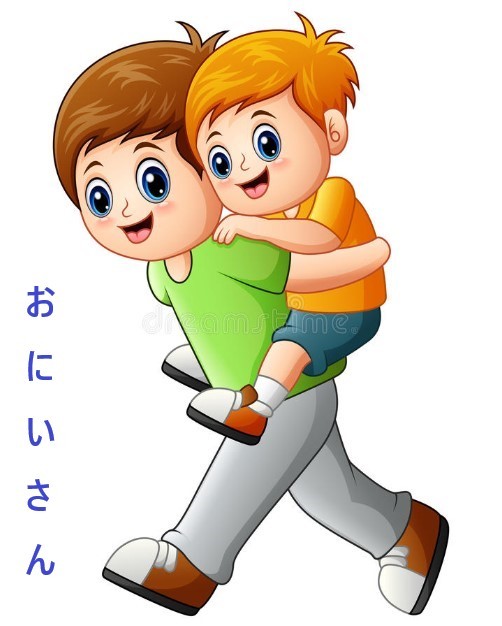
MA, YA and RA lines

- The line with the Y is read like a normal 'i'
Transcribe in Rōmaji:
- みらい
future: - かりる verb
borrow: - やまもと Japanese surname:
- よむ: verb
read - しはらう: verb
pay
Transcribe the following Japanese place names in Hiragana:
- Nara:
- Kokura:
- Kamakura:
- Kumamoto:
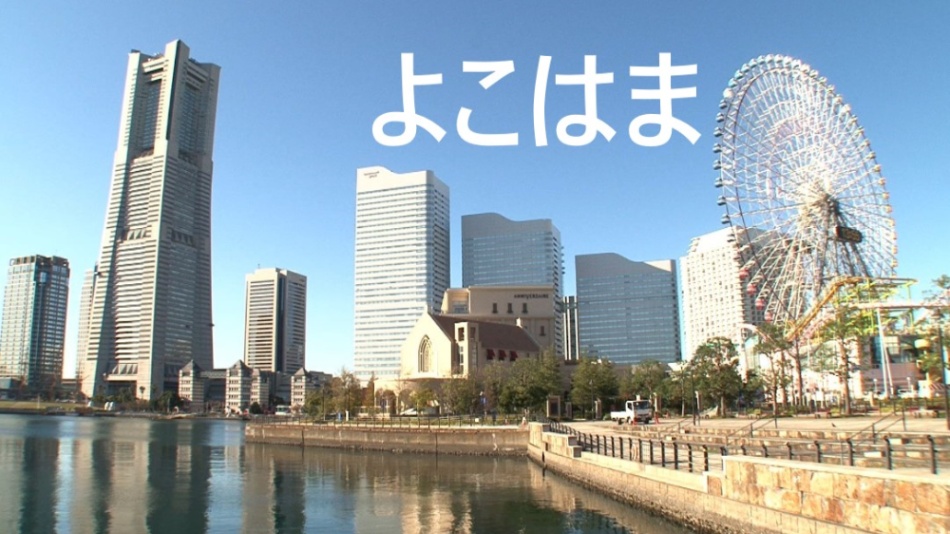
WA, the consonant N and the particle O

- わ WA is read "ua" and is found as kana, as a syllable in the various Japanese words; there is also the particle WA indicating the subject of the sentence and in that case it is always read WA but is transcribed with the character HA は.
- ん "n " is the only single consonant
- を is read "o " and is only used as a particle indicating the object in the sentence
Examples with WA
- わたし
me: watashi; かわriver: kawa; にわgarden: niwa
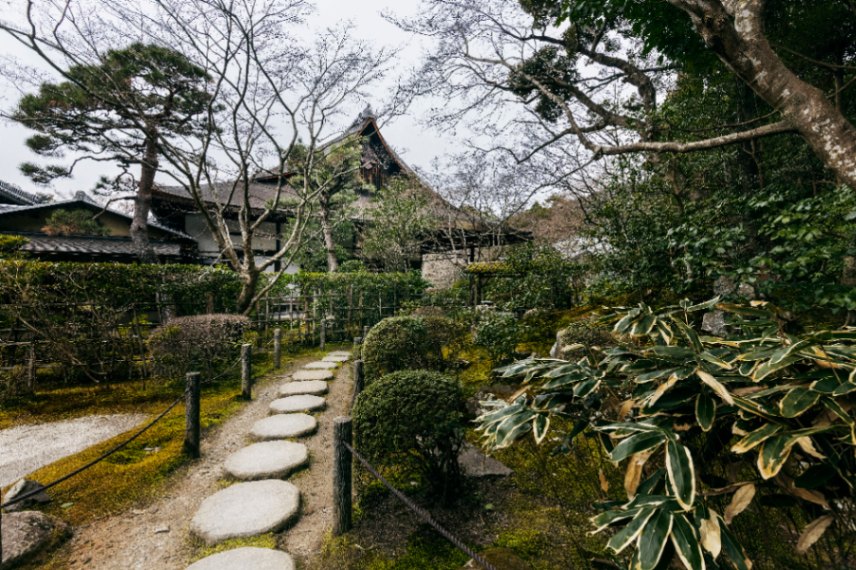
Transcribe a sentence in Japanese
Let's make a short sentence containing the 2 paticles** は** and を.
I'm British.
As we see the particle wa is transcribed with the character は.
Example with the particle を indicating the object.
Please give me some bread.
The particle o indicating the object, is transcribed with the character を and not お which we have seen among the vowels.
Recognising Japanese characters
On a first approach and study of the syllabary, it may happen that the characters appear slightly different from those learned from the hiragana chart. If we consider the same font we normally use for our alphabetical characters, we realise that even in our writing system some letters are sometimes not immediately recognisable.
Context and training can help us to recognise Hiragana charachters and later Katakana characters used for foreign terms, and after this first step we can reach the wonderful world of the Kanji, 漢字 the ideograms.
Characters that might initially be perhaps confused include い the vowel i and the syllable こ ko. In a printed text the distinction is clear, but in a handwritten text it may be that the syllables are written obliquely and then they could be interchanged. Other similar characters are:
- め 'me' meaning
eye - ぬ "nu" as in the word ぬの
cloth,textile - ね "ne" is the exclamative particle placed at the end of the sentence meaning
right?,Isn't it?,Doesn't it?
The context in which the word is placed and the training help to identify the character correctly.
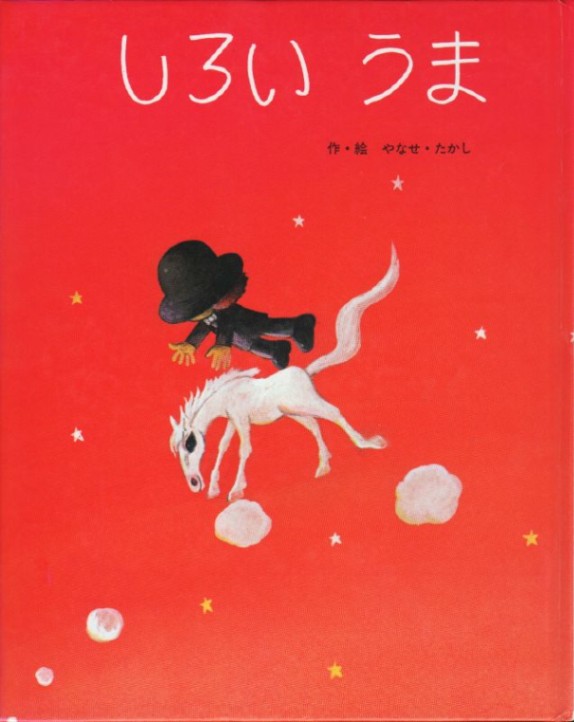
Sign " Dakuten with impure sounds
The diacritical sign (") consists of 2 inverted commas called Dakuten, Tenten or Nigori and is placed in the upper right-hand part of the character whose sound you want to transform.
The (") sign transforms the consonant from voiceless to voiced sounds.
Nigori indicates something impure and unclear and refers to the phonetic change of sound. It often occurs when two terms are joined together.
- はな hana is the
flowerin Japanese; - in the compound word いけばな
Ikebana, as we see the character HA は becomes BA ば; the voiceless (pure) sound は becomes voiced (impure) ば
Let us look at the various lines using Nigori:
The か KA line becomes が GA:
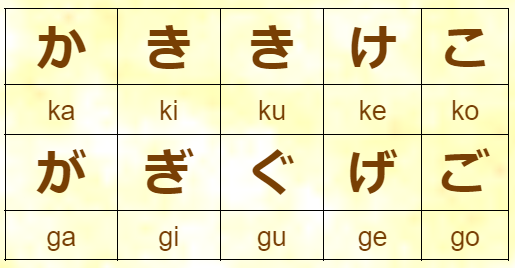
Examples with words containing the line がぎぐげご:
- うごく ugoku verb
move - ながさき city of
Nagasaki - かぎ kagi the
key
The さ SA line becomes ざ ZA:
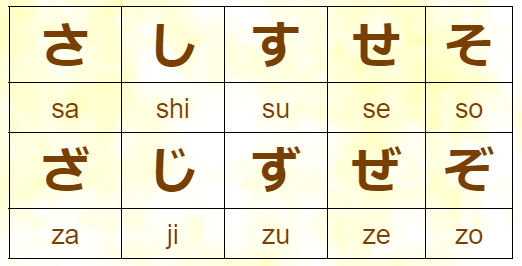
The ZI sound does not exist in Japanese and the character じ is read ji as in Jeans.
Examples:
- かずこ feminine name
Kazuko. - ぞう zō, the
elephant - ざっし zasshi, the
magazine
The た TA line becomes だ DA:

As we see from the table, the sound DI and DU do not exist in Japanese phonetics; the character ぢ is read ji as in Jeans and づ is read zu as in Zoom.
Examples:
- おでん Japanese dish
Oden - どうぞ dōzo,
pleaseform of greeting - つづく tsuzuku, verb
continue
The は HA line becomes ば BA:
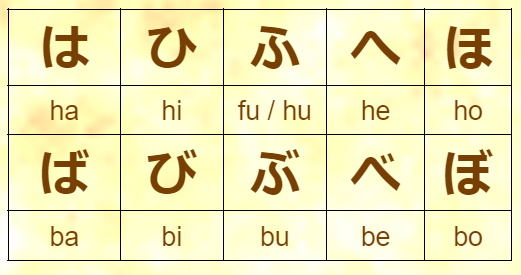
Examples:
- かぶき
Kabuki, classical form of Japanese theatre - ばける bakeru, verb
transform - ひびく hibiku, verb
resound
Sign ° "maru" used with the H line
The sign (°) placed at the top right of the H line characters, transforms the H sound into P; it is called Maru (circle) or Handakuten because it transforms the pure sound into a semi-pure sound.
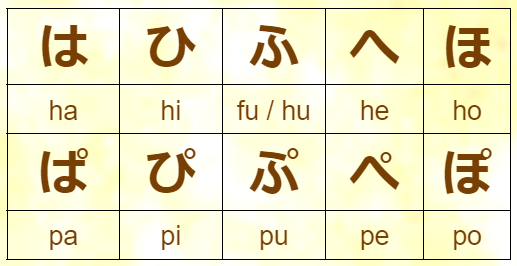
Examples:
- さっぽろ the city of
Sapporo - えんぴつ enpitsu, the
pencil - はっぱ happa, the
leaf
Practice the impure and semi-pure sounds
Read the following words transcribed in Hiragana. For comparison, we reproduce the transcription in Rōmaji at the end.
- がっこう the
school - たべる verb
eat - ともだち
friends - おじいさん the
grandfather - ことば the
words - げつまつ the
end of the month - じぶん
myself,oneself
Try now to transcribe the terms in Hiragana:
- Matte kudasai:
wait please - Sumidagawa:
Sumida river - Oboeru: verb
remember - Konpō:
packaging - Godan Dōshi: the
Godan verbs
Dictation Practise 1
Here is the first audio with some Japanese words to hear and transribe in Hiragana.
0:00.00
-1:0-1.00
書き取りの練習
Dictation practice
Here is another reading exercise of some Aisatsu that you will definitely recognise, because they are commonly used in the Japanese language.
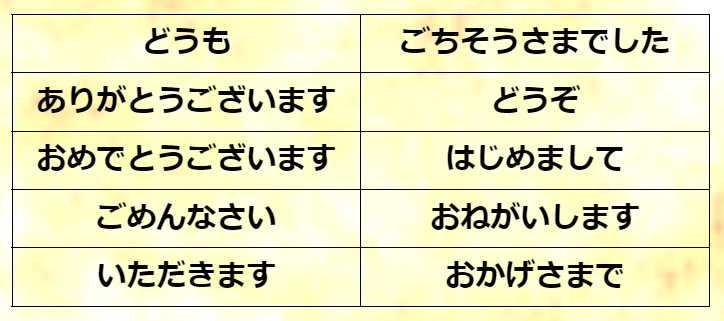
Contracted sounds in Japanese
The contracted sounds join 2 syllables; specifically, they are combinations of the syllables ending with the vowel い with the three characters や, ゆ, よ.
The three characters や, ゆ and よ are transcribed smaller than the main kana.
An example:
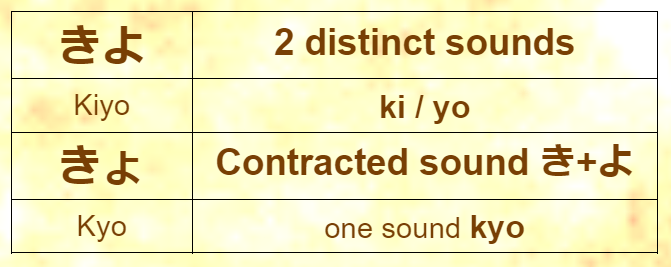
- きよ Kiyo,
female name; we put the 2 kana き and よ together and we have 2 different sounds ki / yo. - the contracted sound becomes: き+よ= きょ Kyo; the resulting sound Kyo is shorter than Kiyo.
きゃ and ぎゃ lines
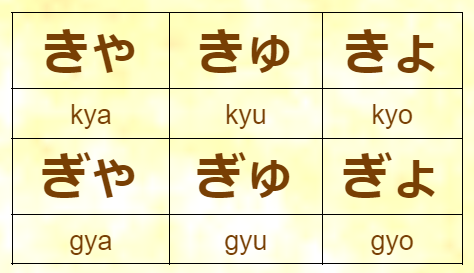
Examples:
- わぎゅう wagyū, means
Japanese cattle - きょう kyō, adverb
today - おきゃく o-kyaku, the
customer, theguest
しゃ e じゃ lines
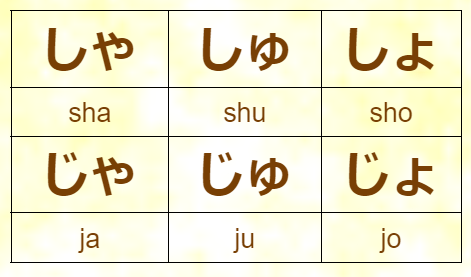
Examples:
- かいしゃ kaisha,
company - じゅうどう the Japanese martial art
Jūdō - じょうほう jōhō, the
information
ちゃ and ぢゃ lines
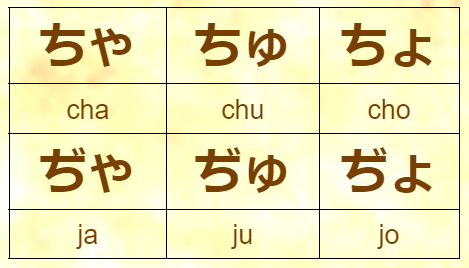
Examples:
- おちゃ o-cha, the
green tea - ちゅうがっこう chūgakkō, the
secondary school - ちょうちょう chōchō, the
butterfly

The syllables ぢゃ、ぢゅ、ぢょ are very rare in the Japanese language; type dya, dyu and dyo on the keyboard to obtain the 3 characters.
Example:
- ぱんぢゅう panjū is a
typical Hokkaidō sweetand uses the character ぢゅ.
ひゃ, びゃ and ぴゃ lines
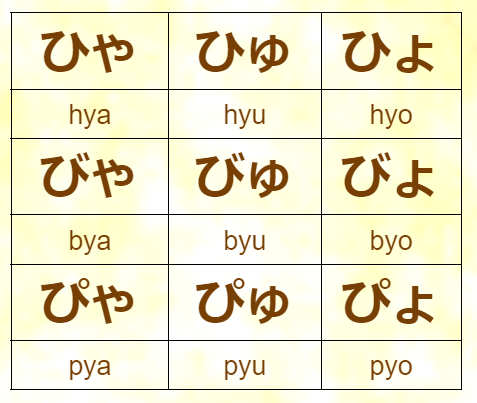
Examples:
- はっぴゃく happyaku, the number
800 - ひょうが hyōga, the
glacier - びゃくだん byakudan, the
sandalwood
にゃ, みゃ and りゃ lines
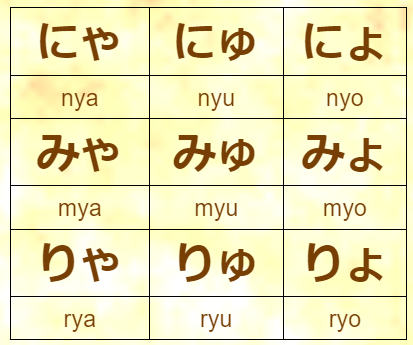
Examples:
- ぎゅうにゅう gyūnyū,
milk - りょこう ryokō, the
travel, thetrip - きみょうな kimyō na, adjective
bizarre,eccentric
Dictation Practise 2
0:00.00
-1:0-1.00
書き取りの練習
Dictation practise
We have completed all the lines and the aspects of the Hiragana syllabary. Here are some short sentences transcribed in Hiragana where you will find some of the characters studied together.
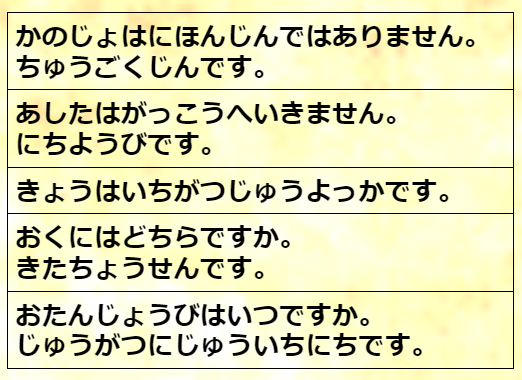
Solutions to the exercises
Here are the transcriptions in Hiragana and Rōmaji that you can compare:
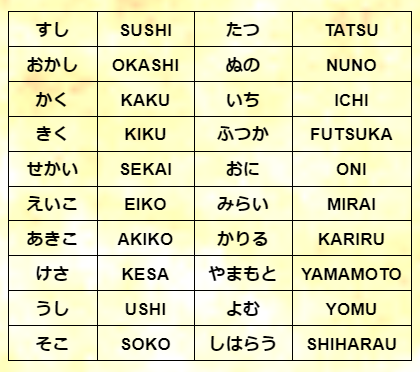
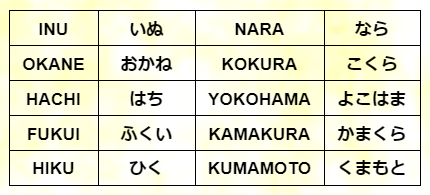


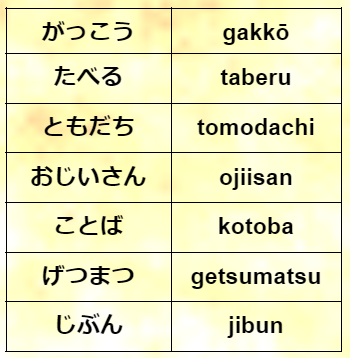
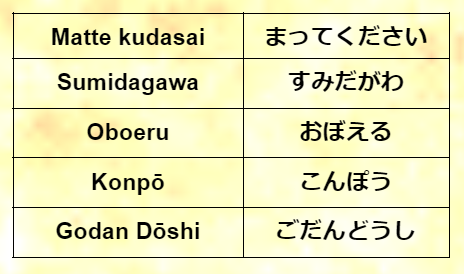
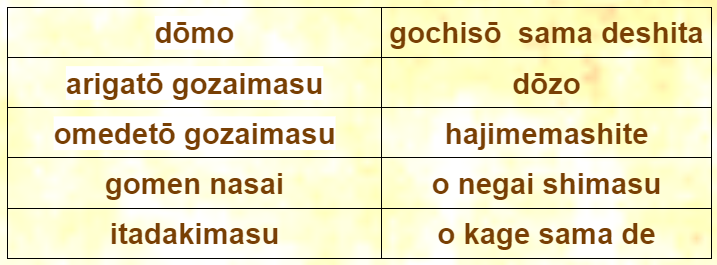

- Dictation 1
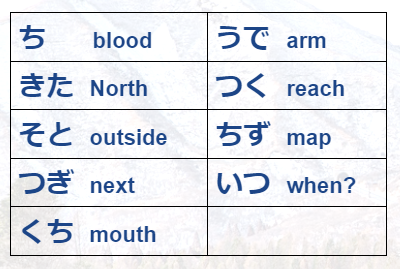
- Dictation 2
